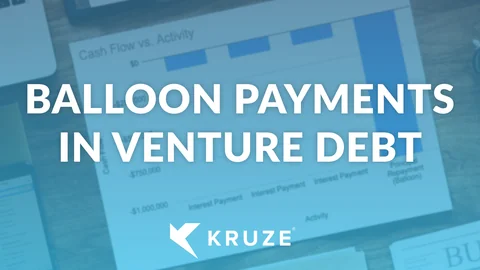
Venture debt has become an increasingly popular financing tool for startups looking to extend their runway without diluting equity. A common feature of many venture debt structures is the “balloon payment.” Understanding how balloon payments work, the benefits, and the risks is crucial for founders who are considering this form of capital.
What Is a Balloon Payment in Venture Debt?
A balloon payment is a large, lump-sum payment due at the end of a loan term. In a typical venture debt arrangement, startups will only make interest payments (or very small principal payments) throughout the life of the loan, with the full principal amount due in a single payment at maturity. This structure is particularly common in “interest-only” or “bullet” loans, which are designed to preserve cash flow during critical growth periods.
Why Would Startups Accept Balloon Payments?
Startups use balloon payments to get immediate access to capital while keeping their monthly payments low. That way they can defer the bulk of repayment until later, when they anticipate having more revenue or funding available. Balloon payment structures are attractive for startups for several other reasons:
- Cash flow flexibility. By deferring principal repayment, startups can preserve working capital to spend on growth, including hiring, product development, or market expansion.
- Lower monthly payments. Interest-only payments during the loan term keep recurring obligations manageable, which is very valuable for companies with unpredictable or seasonal revenue.
- Funding bridge. Balloon loans can serve as bridge financing, giving startups time to reach key milestones or secure additional venture funding before the large payment comes due.
How Balloon Payments Work: An Example
Suppose a startup borrows $1 million in venture debt with a 3-year term at 10% interest. For the first 36 months, the company pays only interest, which would be $8,334 per month. At the end of the term, the entire $1 million principal is due as a single balloon payment.
Risks and Considerations
While balloon payments offer flexibility, they can also pose a significant risk to startups, particularly if they face unexpected financial setbacks. Risks include:
- Default risk. If the startup isn’t earning revenue, or if an anticipated cash event (like a funding round or exit) doesn’t materialize before the balloon payment comes due, the startup could end up in default, damaging credit and potentially resulting in loss of assets or equity.
- Refinancing uncertainty. Startups may plan to refinance the balloon payment; however, changes in market conditions or company performance may make refinancing difficult or more expensive.
- Higher interest rates. Loans with balloon payment structures often carry higher interest rates than traditional loans, because of the increased default risk with startups that lenders face.
Best Practices for Startups Considering Balloon Payments
Balloon payments in venture debt can be a powerful tool for startups needing immediate capital with minimal monthly payments. However, the structure requires careful planning and risk management. Founders should:
- Plan for repayment. Only take on a balloon loan if you have a clear, realistic plan for how you will make the final payment – whether through revenue, a funding round, or an exit.
- Monitor cash flow closely. Make sure your cash flow allows you to meet interest obligations and build reserves for the balloon payment if possible.
- Explore alternatives. Consider whether a traditional amortizing loan or equity financing might be a better fit for your risk profile and growth stage.
- Communicate with stakeholders. Keep investors and board members informed about your debt obligations and repayment strategy.
In short, founders considering balloon loans should weigh the benefits of cash flow flexibility against the risks of a large, looming debt obligation – and always have a backup plan in place.








